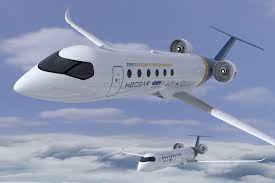Within the next 20 years, passengers could be flying between UK regions in planes emitting no carbon, a squadron of heavy-lifters in commercial aviation claimed today.
By 2040 Britain can be a global leader in hydrogen-powered commercial flight, but a national hydrogen strategy is fundamental to meeting aviation’s needs in distribution, gas provisioning and cost, says a consortium headed by operators easyJet, British Airways and Loganair.
The airlines have joined Heathrow and London City airports, engine builders Rolls-Royce & GKN and aviation-focused universities UCL and Cranfield, seeking clearance for take-off of hydrogen-fuelled flight from controllers in Whitehall’s & Westminster’s towers.
On the first day of the key CoP27 climate talks in Sharm el-Sheikh, Egypt, the consortium offers their detailed ‘Project Napkin’ vision to British decision-makers.
The flyers have filed their ‘Napkin’ flight plan as the most comprehensive study yet made into carbon-lite H2’s potential to replace carbon-laden avgas by 2040 over internal UK routes. The study’s feasibility findings already include:
- As early as 2026, conventional jets converted to burn 100% hydrogen, now in advanced development at Cranfield, could be linking the UK mainland with island communities
- City Airport, London’s business-focused hub, has potential to operate an entirely zero emission domestic network from 2035
- Hydrogen-fuelled planes seating up 90, already in blueprint at GKN Aerospace and Rolls-Royce, could be flying 2,600km on flights into Europe by 2040, according to feasibilities completed by University College London.
- By 2040, global hub Heathrow could welcome 90-seat zero emission planes from UK airports, decanting passengers on to intercontinental carriers using the latest sustainable aviation fuels.
Modelling by Cranfield University persuades the consortium that larger UK airports will need by 2035 to have converted bowsers, hydrogen tanks and buried pipelines, meeting demand for the gas set to grow on average 68% each and every year.
By 2035, London City may need storage facilities for 1,000 tonnes of hydrogen every year, probably by waterborne delivery up the Thames
By 2040, Heathrow should be considering making H2 on-site, as it refuels jets with up to 90,000 tonnes of the gas annually
Napkin: a tonic with legroom, or just nuts?
As much as 300,000 tonnes of green hydrogen will be needed by 2040, ‘Project Napkin’ estimates, as more airlines switch to zero emission aircraft. To meet that target, the consortium recommends a cross-Whitehall, pan-industry re-think of how aviation fits into the nation’s Hydrogen Strategy. First sketched by the Johnson administration in August 2021, the guide targets 10GW of British production capacity in hydrogen this decade.
With Germany already investing 8 billion Euros in 62 big H2 projects, and France puffing 7.2 billion Euros into making the renewable gas, the ‘Napkin’ team see the world’s competition to lead in clean aviation fuel as already underway.
Cranfield Aerospace’s chief strategy officer Jenny Kavanagh explained: “The goal of Project Napkin was to ascertain whether a carbon-free aviation system could be economically viable in the UK.
“The answer is Yes – it is within our power to achieve.
“The transition to zero carbon flying will take time. But it is a process which must start, and is starting, now”, Kavanagh added.
“We in the consortium stand ready to work with government, industry, and partners globally from all sectors, so we can meet the clear and present environmental challenge, continue to connect people and places, and position the UK at the vanguard of clean aviation”.
The full Project Napkin report is here.




